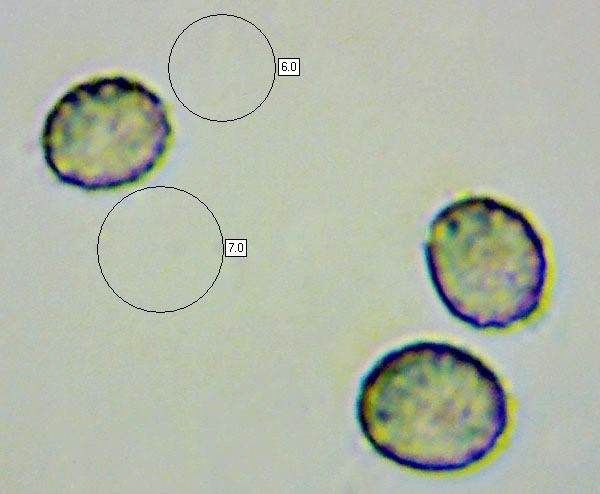Russula cyanoxantha (Schaeff.) Fr. - Charcoal Burner
Phylum: Basidiomycota - Class: Agaricomycetes - Order: Russulales - Family: Russulaceae
Distribution - Taxonomic History - Etymology - Identification - Culinary Notes - Reference Sources
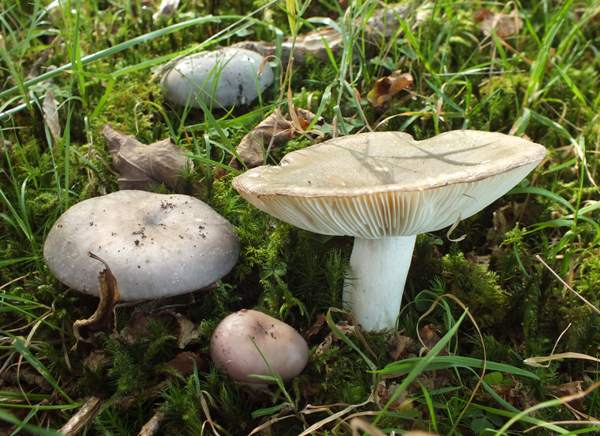
Russula cyanoxantha is one of the many brittlegills whose cap colours are of very little help in the identification process. Although the Coarcoal Burner is most often found with reddish-purple colouring, the peltereaui form illustrated by the larger specimen on the left is wholly green. Other common cap colours include mixtures of violet, brown, yellow, blue, grey - all shades seen when charcoal burns. This common is usually plentiful in beechwoods and under grand old trees in parkland.
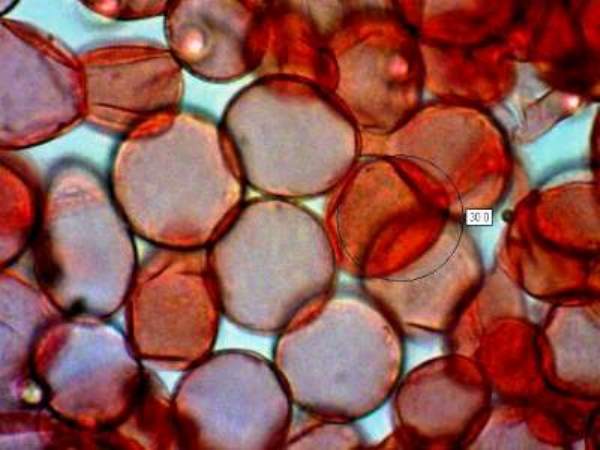
This is a brittle mushroom (apart from its gills), and the reason for its crumbly texture is the high proportion of sphaerocysts - rounded hyphal cells - in the flesh of the mushroom. All members of the Russulacea (and some other families) have sphaerocysts within their fruitbodies, the proportion varying from species to species.
The picture shown above is of the sphaerocysts in the stem of Russula cyanoxantha, the Charcoal Burner, stained with Congo Red. They make the stem as brittle as a stick of charcoal!
Unlike the warty spores of a brittlegill fungus, phaerocysts are very easy to see clearly with an optical microscope, because they are about five times bigger than a typical spore. In the examples shown here the sphaerocysts are more or less spheroidal and about 30μm in diameter. (μm is short for a micron, and one micron is one thousandth of a millimetre.)
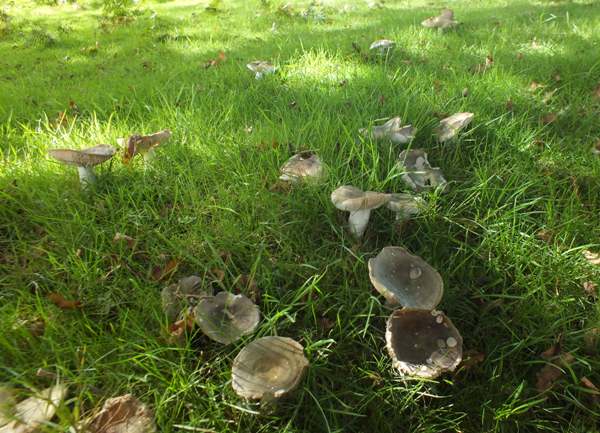
Distribution
Very common and widespread in woodland that contains broadleaf trees, Russula cyanoxantha occurs throughout Britain and Ireland and wherever there are oak and beech trees on mainland Europe. This brittlegill occurs also in parts of North America.
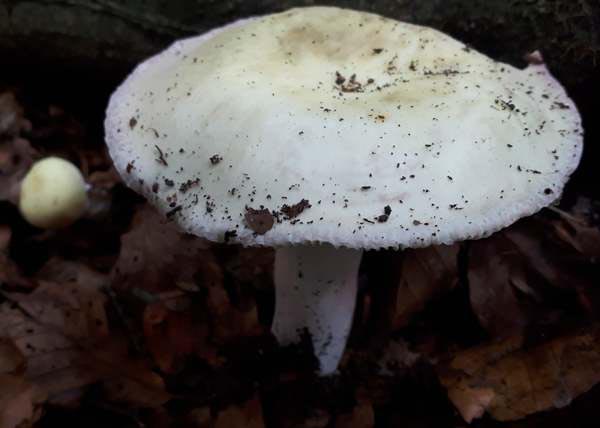
Taxonomic history
The Charcoal Burner mushroom was described in 1762 by Jacob Christian Schaeffer, who gave it the binomial scientific name Agaricus cyanoxanthus. (Most gilled fungi were initially placed in a giant Agaricus genus, now largely redistributed to many other genera.)
In 1863 the great Swedish mycologist Elias Magnus Fries transferred this species to the genus Russula, establishing its currently-accepted scientific name Russula cyanoxantha.
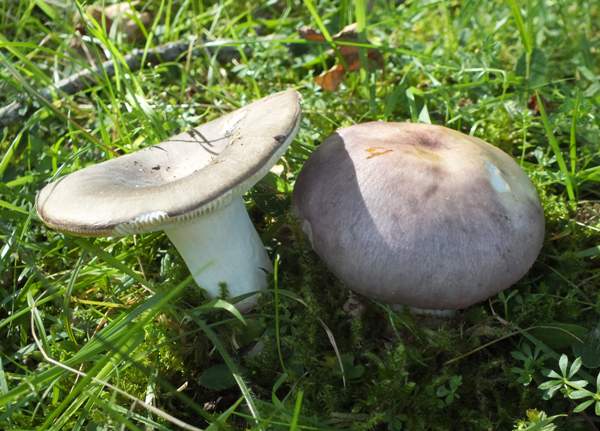
Synonyms of Russula cyanoxantha include Agaricus cyanoxanthus Schaeff., Russula furcata, Russula cyanoxantha var. cyanoxantha (Schaeff.) Fr., Russula cutefracta Cooke, Russula cyanoxantha f. pallida Singer, Russula cyanoxantha f. peltereaui Singer, Russula cyanoxantha var. cutefracta (Cooke) Sarnari, and Russula cyanoxantha f. cutefracta (Cooke) Sarnari.
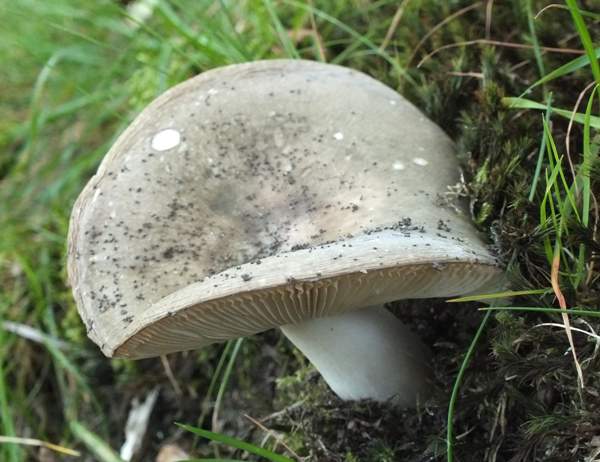
Etymology
Russula, the generic name, means red or reddish, and indeed many of the brittlegills have red caps (but many more are not, and several of those that are usually red can also occur in a range of other colours!). The specific epithet cyanoxantha comes from cyan- meaning blue and -xantha meaning yellow or blond - suggesting only a limited combination of the many colours seen in caps of these brittlegill mushroom.
Run a finger gently across the gills of most other Russula species and you create a snowstorm of broken gill fragments. Not so with Russula cyanoxantha, whose gills simply bend under pressure and spring back into shape afterwards. This, I suggest, should be the very first test you try if you believe that you have found a Charcoal Burner mushroom. If a brittlegill passes the 'rubber gills' test it is then worth going ahead with a taste test - Charcoal Burners are mild and will not burn your tongue.
Identification guide
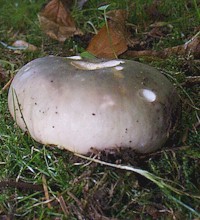 |
Cap5 to 15cm in diameter, the caps are almost spherical at first, becoming convex and later flattening with a slight central depression; peeling to 1/2 way to centre. Beneath the cuticle, which varies in colour from purple and brown to grey and (in Russula cyanoxantha var. peltereaui) green and is darker towards the centre, the flesh of this mushroom is white and firm. |
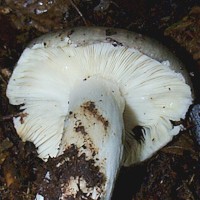 |
GillsThe greasy white, crowded, adnexed to very slightly decurrent gills are sometimes forked; they are unusually pliable for a Russula species. |
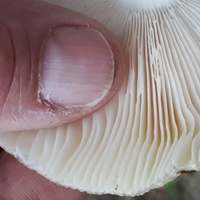 |
The gills of Russula cyanoxantha are unusually pliable for a Russula species. |
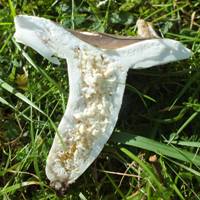 |
Stem15 to 30mm in diameter, cylindrical and 5 to 10cm tall, the stems are white, occasionally tinged with purple. The stem flesh is also white, and there is no stem ring. |
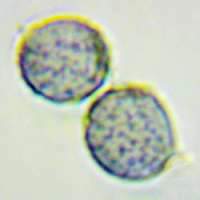 |
SporesEllipsoidal, 7-9 x 5-6μm (excluding spines); ornamented with blunt isolated warts up to 0.5μm tall. (The spores shown on the left were stained using Melzer's Reagent, which makes the warts more clearly visible.) Spore printWhite. |
Odour/taste |
No distinctive odour ('mushroomy'); mild taste. |
Habitat & Ecological role |
Particularly common in broadleaf woodland containing oaks and Beech but also found with conifers. In common with other members of the Russulaceae, Russula cyanoxantha is an ectomycorrhizal mushroom. |
Season |
July to November in Britain and Ireland. |
Similar species |
Russula xerampelina is equally variable in cap colour; it is commonly referred to as the Crab Brittlegill because of its distinctive fishy odour. Russula cyanoxantha var. cutefracta has a minutely quilted (crazy-paving-like) cap and could therefore be mistaken for Russula virescens unless other features (for example as its darker creamy spore print) are checked carefully. |
Culinary Notes
For those with the experience to identify them with certainty (and the flexible gills are one key feature to bear in mind), Charcoal Burners are good edible mushrooms with a mild nutty taste. The flesh is rather softer than that of most other edible brittlegills, but it does still retain a good texture after being cooked. Sautéed with onions and garlic they can be served with meat dishes; alternatively they make nice omelette fillings or they can be used in mushroom soups or stews.
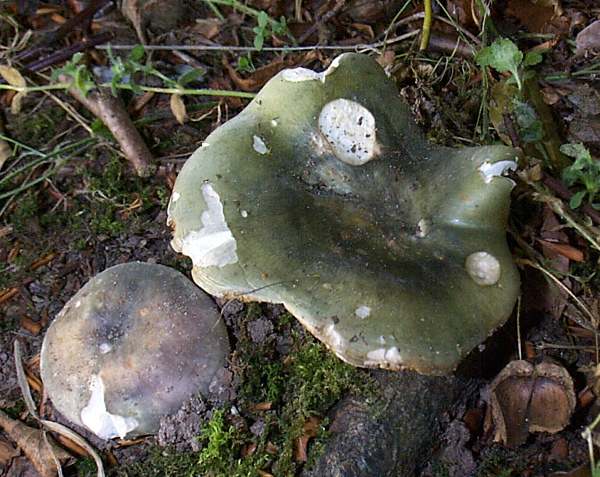
Reference Sources
Pat O'Reilly (2016). Fascinated by Fungi, First Nature Publishing
Geoffrey Kibby (2011).The Genus Russula in Great Britain, published by G Kibby.
Roberto Galli (1996). Le Russule. Edinatura, Milan.
Paul M. Kirk, Paul F. Cannon, David W. Minter and J. A. Stalpers. (2008). Dictionary of the Fungi; CABI.
Taxonomic history and synonym information on these pages is drawn from many sources but in particular from the British Mycological Society's GB Checklist of Fungi.
Fascinated by Fungi. Back by popular demand, Pat O'Reilly's best-selling 450-page hardback book is available now. The latest second edition was republished with a sparkling new cover design in September 2022 by Coch-y-Bonddu Books. Full details and copies are available from the publisher's online bookshop...
